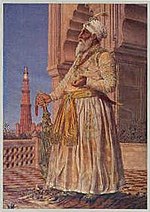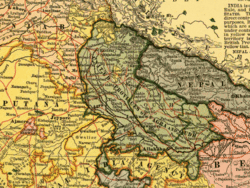Awadh
Awadh | |
|---|---|
 Modern map of the Awadh region | |
| Continent | Asia |
| Country | India |
| State | Uttar Pradesh |
| Covering territory | |
| Languages | |
| Area | |
| • Total | 68,006 km2 (26,257 sq mi) |
| Population (2011) | |
| • Total | 55,119,236[citation needed] |
| Largest Cities | |

Awadh (Hindi:
It was a province of all the major Islamic dynasties in India including the Mughal Empire. With the decline of late Mughal Delhi, Awadh became a major source of literary, artistic, religious, and architectural patronage in northern India under the rule of its eleven rulers, called Nawabs. From 1720 to 1856, the nawabs presided over Awadh, with Ayodhya and Faizabad serving as the region's initial capitals.[3] Later, the capital was relocated to Lucknow, which is now the capital of Uttar Pradesh.[4]
The British conquered Awadh in 1856, which infuriated Indians and was recognised as a factor causing Indian Mutiny (1857-58), the biggest Indian uprising against British rule.[5]
Etymology
The word Awadh is inherited from the Sanskrit word Ayodhya meaning "not to be warred against, irresistible".[6][7][8]
History
Awadh, known as the granary of India, was important strategically for the control of the
.Ancient
Awadh's political unity can be traced back to the ancient
Modern Awadh finds historical mention only in the Mughal time of Akbar, in the late 16th century.
In prehistoric times, Awadh, reputedly the kingdom of Bikukshi, contained five main divisions :[10]
- .
- Taraiat its base.
- districts.
- Ambedkarnagar), the north-eastern corner of Sultanpur, and parts of Mirzapur district, Pratapgarh District and Jaunpur.
- Arbar, extended southwards from Gomti to the Sai river.
Before independence
Since AD 1350 different parts of the Awadh region were ruled by the
For about eighty-four years (from 1394 to 1478,), Awadh was part of the
Awadh under the Mughals
From the pre-historic period to the time of
(districts).Khan Zaman Khan Ali Asghar son of Qazi Ghulam Mustafa was appointed as Subahdar of Awadh during the reign of Farrukhsiyar. This appointment was made in place of 'Aziz Khan Chughtai'.[13] Later on, Mahabat Khan was appointed as Subahdar of Awadh in place of Khan Zaman Khan Ali Asghar, who was all over again transferred to Azimabad (Patna) as Subahdar in place of 'Sar Buland Khan'.[14]

It seems to have been of nearly the same extent as the Province of Oudh at the time of annexation to
Under the hereditary Nawabs of Awadh




As the
The Nawabs of Awadh were a
Awadh was known as the granary of India and was important strategically for the control of the
The third Nawab,

In 1798, the fifth Nawab


Coins were struck under the nawab's control for the first time in 1737, at a new mint opened in
The wars and transactions in which Shuja-ud-Daula was engaged, both with and against the
British rule

The treaty of 1801 formed an arrangement that was very beneficial to the company. They were able to use Awadh's vast treasuries, repeatedly digging into them for loans at reduced rates. In addition, the revenues from running Awadh's armed forces brought them useful revenues while it acted as a buffer state. The Nawabs were ceremonial kings, limited to pomp and show but with little influence over matters of state. By the mid-19th century, however, the British had grown impatient with the arrangement and wanted direct control. They started looking about for an excuse, which the powerless Nawabs had to provide. On 1 May 1816, a British protectorate was signed.

In 1856 the East India Company annexed the state under the
In the
The Tarai to the north of

In 1877 the offices of lieutenant-governor of the North-Western Provinces and chief commissioner of Oudh were combined in the same person; and in 1902, when the new name of United Provinces of Agra and Oudh was introduced, the title of chief commissioner was dropped, though Oudh still retained some marks of its former independence.
Rulers
- Subadar Nawabs
- 1732 – 19 March 1739 Borhan al-Molk Mir Mohammad Amin Musawi Sa`adat `Ali Khan I (b. c. 1680 – d. 1739)
- 19 March 1739 – 28 April 1748 Abu´l Mansur Mohammad Moqim Khan (1st time) (b. c. 1708 – d. 1754)
- Nawab Wazir al-Mamalik
- 28 April 1748 – 13 May 1753 Abu´l Mansur Mohammad Moqim Khan (s.a.) (acting to 29 June 1748)
- Subadar Nawabs
- 5 November 1753 – 5 October 1754 Abu´l Mansur Mohammad Moqim Khan (s.a.) (2nd time)
- 5 October 1754 – 15 February 1762 Jalal ad-Din Shoja` ad-Dowla Haydar (b. 1732 – d. 1775)
- Nawab Wazir al-Mamalik
- 15 February 1762 – 26 January 1775 Jalal ad-Din Shoja` ad-Dowla Haydar (s.a.)
- 26 January 1775 – 21 September 1797 Asaf ad-Dowla Amani (b. 1748 – d. 1797)
- 21 September 1797 – 21 January 1798 Mirza Wazir `Ali Khan (b. 1780 – d. 1817)
- 21 January 1798 – 11 July 1814 Yamin ad-Dowla Nazem al-Molk Sa`adat `Ali Khan II Bahadur (b. bf. 1752 – d. 1814)
- 11 July 1814 – 19 October 1818 Ghazi ad-Din Rafa`at ad-Dowla Abu´l-Mozaffar Haydar Khan (b. 1769 – d. 1827)
- Kings (title Padshah-e Awadh, Shah-e Zaman)
- 19 October 1818 – 19 October 1827 Ghazi ad-Din Mo`izz ad-Din Abu´l-Mozaffar Haydar Shah (s.a.)
- 19 October 1827 – 7 July 1837 Naser ad-Din Haydar Solayman Jah Shah (b. 1803 – d. 1837)
- 7 July 1837 – 17 May 1842 Mo`in ad-Din Abu´l-Fath Mohammad `Ali Shah (b. 1777 – d. 1842)
- 17 May 1842 – 13 February 1847 Naser ad-Dowla Amjad `Ali Thorayya Jah Shah (b. 1801 – d. 1847)
- 13 February 1847 – 7 February 1856 Naser ad-Din `Abd al-Mansur Mohammad Wajed `Ali Shah (b. 1822 – d. 1887)
- 5 July 1857 – 3 March 1858 Berjis Qadr, son of the above (in rebellion) (b. c. 1845 – d. 1893)
Demographics
Religion
A vast majority of the population practices
Culture
The region of Awadh is considered to be the center of Ganga-Jamuni culture.[22]
Sham-e-Awadh
Sham-e-Awadh is a popularised term referring to the "glorious evenings" in the Awadh capitals of Faizabad and later (and even today and to a greater extent) Lucknow.[citation needed]
Awadh was established in 1722. with Faizabad as its capital.
, shifted the capital from Faizabad to Lucknow; this led to the decline of Faizabad and rise of Lucknow.Just as Banares (Varanasi) is known for its mornings, so Lucknow is for its evenings.[citation needed] Many of its well-known buildings were erected on the banks of the Gomti River in the time of Nawabs. The Nawabs used to take in a view of the river Gomti and its architecture in the evening hours, giving rise to Sham-e-Awadh's romantic reputation.[23]
There is a saying:'Subah-e-Benares', 'Sham-e-Awadh', 'Shab-e-Malwa' meaning mornings of the Benares, evenings of the Awadh and nights of Malwa.
Awadhi cuisine

Awadhi Cuisine is primarily from the city of Lucknow and its environs. The cooking patterns of the city are similar to those of Central Asia, the Middle East, and
foods.The .
In popular culture
The events surrounding the 1856 overthrow of Wajid Ali Shah and the annexation of Awadh by the British are depicted in the 1977 film
The 1961 film
The novel Umrao Jaan Ada as well as the subsequent films are based on two cultural cities of Awadh, Lucknow and Faizabad.
The region has been in the center of various period films of Bollywood and modern films like
See also
- Nawab of Awadh
- List of chief commissioners of Oudh
- House of Tulsipur
- Pasi
- Baruwar (Rajput clan)
References
- ^ "Gate of the Loll-Baug at Fyzabad". British Library, Online Gallery. Archived from the original on 12 December 2011. Retrieved 26 November 2019.
- ^ Awadh, historic region, India. 31 January 2013. Archived from the original on 20 January 2022. Retrieved 15 January 2022.
{{cite encyclopedia}}:|website=ignored (help) - ISBN 978-1-85649-050-4. Archivedfrom the original on 9 February 2024. Retrieved 29 December 2022.
- from the original on 10 March 2024. Retrieved 29 December 2022.
- ^ "Awadh | historic region, India | Britannica". www.britannica.com. Archived from the original on 19 October 2022. Retrieved 29 December 2022.
- ^ Mohamed nasr. Subah Of Awadh Under The Mughals 1582 1724. p. 1.
- ^ "Imperial Gazetteer2 of India, Volume 24, page 132 -- Imperial Gazetteer of India -- Digital South Asia Library". dsal.uchicago.edu. Archived from the original on 29 June 2022. Retrieved 20 June 2022.
- ^ "Sanskrit Dictionary". Archived from the original on 29 December 2022. Retrieved 29 December 2022.
- ^ "Ayodhya | History & Facts | Britannica". www.britannica.com. Archived from the original on 29 December 2022. Retrieved 29 December 2022.
- ^ Irwin, Henry Crossly (1880). The Garden of India. Or, Chapters on Oudh History and Affairs. London: W. H. Allen. p. 106.
 This article incorporates text from this source, which is in the public domain.
This article incorporates text from this source, which is in the public domain.
- ^ "Faizabad, town, India". The Columbia Encyclopedia, 6th Edition. 2001–07 Archived 7 September 2005 at the Wayback Machine
- ^ "Lucknow City". Laxys.com. Archived from the original on 26 December 2018. Retrieved 29 April 2012.
- ^ Tazkirat us-Salatin Chaghta – A Mughal Chronicle of Post Aurangzeb Period (1707–1724) by Muhammad Hadi Kamwar Khan; edited Persian text and with an Introduction by Muzaffar Alam (1980), Centre of Advanced Study Department of History, Aligarh Muslim University, Aligarh (U.P.) -202001, India(page 234)
- ^ Tazkirat us-Salatin Chaghta – A Mughal Chronicle of Post Aurangzeb Period (1707–1724) by Muhammad Hadi Kamwar Khan; edited Persian text and with an Introduction by Muzaffar Alam (1980), Centre of Advanced Study Department of History, Aligarh Muslim University, Aligarh (U.P.) -202001, India(page 236)
- ^ a b c Irwin, Henry Crossly (1880). The Garden of India. Or, Chapters on Oudh History and Affairs. London: W. H. Allen. p. 107.
 This article incorporates text from this source, which is in the public domain.
This article incorporates text from this source, which is in the public domain.
- ^ "Welcome to Faizabad History". official website of Faizabad district. Archived from the original on 28 December 2011. Retrieved 23 December 2011.
- ^ Sacred space and holy war: the politics, culture and history of Shi'ite Islam By Juan Ricardo Cole
- ^ Art and culture: endeavours in interpretation By Ahsan Jan Qaisar, Som Prakash Verma, Mohammad Habib
- ^ a b Encyclopædia Iranica "Avadh" Archived 17 May 2017 at the Wayback Machine, E. Yarshater
- ^ "Faizabad, town, India" Archived 7 September 2005 at the Wayback Machine. The Columbia Encyclopedia, 6th Edition. 2001–07
- ^ P.L. Gupta: Coins, 4th ed., New Delhi: National Book Trust, p. 178.
- ISBN 978-81-89833-18-3, archivedfrom the original on 10 March 2024, retrieved 1 October 2016,
... developed in Awadh as a genre of composite creativity. ... of multiple Indian cultural traditions and provided glimpses of the Ganga-Jamuni tehzeeb of north India with Lucknow as its centre ...
- ^ "Lucnow revisited again". lucknowrevisited.blogspot.com Monday, 26 February 2007. Archived from the original on 11 June 2012. Retrieved 11 January 2012.
- ^ The Sunday Tribune – Spectrum – Lead Article Archived 14 June 2013 at the Wayback Machine. Tribuneindia.com (13 July 2003). Retrieved on 18 July 2013.
Further reading
- "Oudh". The Imperial Gazetteer of India. 1909. p. 277.
External links







